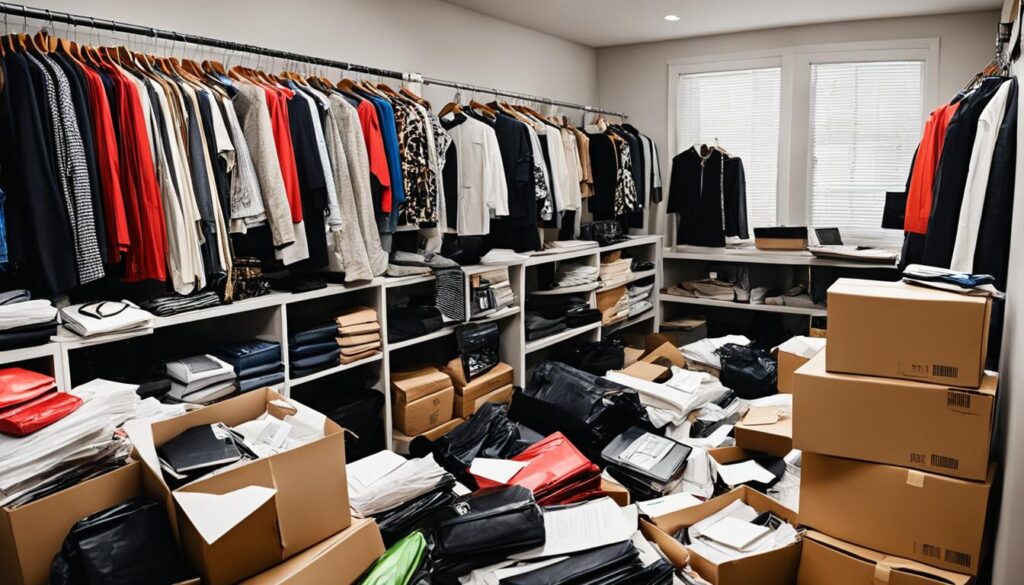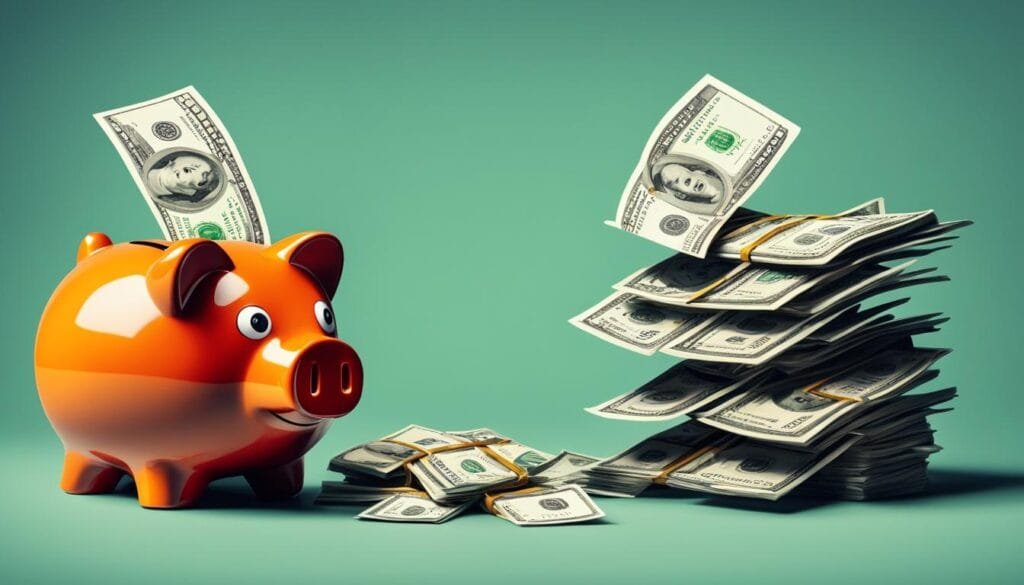Shopping addiction is a chronic disorder that affects many individuals, leading to excessive shopping behavior and compulsive buying tendencies. It is a condition where individuals have little control over their fixation and compulsive behavior related to shopping. This behavior can result in financial distress, increased credit card debt, and emotional satisfaction derived from shopping.
Those with shopping addiction may hide their shopping purchases and become preoccupied with thoughts about shopping, neglecting their responsibilities in the process. This addiction can also have a detrimental impact on relationships, leading to issues and conflicts. Shopping addiction is a serious matter that requires attention and understanding.
Key Takeaways:
- Shopping addiction is a chronic disorder characterized by excessive shopping behavior and compulsive buying tendencies.
- Individuals with shopping addiction often experience financial distress and increased credit card debt from their excessive shopping habits.
- Shopping addiction can also lead to emotional satisfaction derived from shopping, which further reinforces the addictive behavior.
- People with shopping addiction may hide their shopping purchases and become consumed by thoughts about shopping, neglecting their other responsibilities in the process.
- Relationships can be negatively impacted by shopping addiction, leading to conflicts and issues within personal connections.
- Seeking help and professional therapy is crucial for individuals struggling with shopping addiction.
- Identifying triggers, removing temptation, and finding alternative activities can help break the cycle of compulsive shopping.
How Behavioral Addictions Work
Behavioral addictions, including shopping addiction, occur when certain behaviors stimulate the brain’s pleasure center, leading to feelings of satisfaction. Just like drugs or alcohol can stimulate the release of dopamine, shopping can also have a similar effect.
When individuals engage in shopping, their brain releases dopamine, a neurotransmitter associated with pleasure and reward. The pleasure center of the brain, which includes the nucleus accumbens and the prefrontal cortex, is activated, resulting in a sense of satisfaction and well-being.
This surge of dopamine reinforces the behavior and creates a positive association with shopping. Over time, individuals may develop a compulsive urge to engage in shopping to experience this pleasurable sensation again.
However, as with any addiction, the desire for this “high” can become all-consuming. Individuals may lose control and find themselves engaged in the behavior despite negative consequences. These consequences may include financial problems, strained relationships, and a decline in overall well-being.
“Behavioral addictions, such as shopping addiction, can be just as powerful as substance addictions. The neurological response to pleasurable behaviors, like shopping, and the subsequent compulsive behavior are similar to the patterns observed in substance abuse. It’s a complex interaction between brain chemistry and learned behavior.” – Dr. Emily Johnson, Neuroscientist
Shopping addiction is still a topic of ongoing research and debate within the medical community. While some experts argue that it should be recognized as an official disorder, others believe it falls under the broader category of behavioral addictions. Nonetheless, the symptoms and negative consequences of shopping addiction are recognized as significant and require attention and intervention.
To illustrate the impact of behavioral addictions, including shopping addiction, on the brain, here is a simplified diagram:
The Brain and Behavioral Addictions
| Brain Area | Function | Effect of Behavioral Addictions |
|---|---|---|
| Nucleus Accumbens | Responsible for pleasure and reward | Activated when engaging in pleasurable activities, such as shopping |
| Prefrontal Cortex | Regulates decision-making and impulse control | Impaired by behavioral addictions, leading to lack of control and compulsive behavior |
| Amygdala | Processes emotions and triggers the release of stress hormones | Can be overactivated by behavioral addictions, leading to increased emotional distress and cravings |
Understanding how behavioral addictions, such as shopping addiction, impact the brain can provide valuable insights into the nature of these addictive behaviors. By recognizing the neurological underpinnings of addiction, researchers and healthcare professionals can develop effective strategies for prevention, treatment, and recovery.
What is a Shopping Addiction?
A shopping addiction is a chronic disorder characterized by compulsive behavior and a preoccupation with shopping. Individuals with a shopping addiction often find themselves unable to control their urge to shop and frequently engage in excessive buying habits. This compulsive behavior can have negative consequences on various aspects of their lives, including their finances, relationships, and overall well-being.
One common characteristic of a shopping addiction is the hiding of shopping sprees. Individuals may feel a sense of guilt, shame, or embarrassment after indulging in a spending spree and therefore conceal their purchases from others. The secrecy surrounding their shopping habits may contribute to feelings of isolation and further exacerbate their addictive behavior.
People with a shopping addiction often find themselves juggling accounts and bills in order to accommodate their spending habits. They may struggle to meet their financial obligations due to excessive shopping, leading to financial distress and potential debt. The constant need to manage and rearrange their finances adds another layer of stress to their lives.
“Shopping addiction can put a strain on relationships as well. Arguments about shopping habits are common among individuals struggling with this addiction, as their preoccupation with shopping can lead to neglecting other responsibilities or prioritizing shopping over the needs of their loved ones.”
It is important to note that a shopping addiction is not simply a matter of enjoying shopping or having a preference for certain items. It goes beyond normal shopping behavior and becomes a compulsive and excessive habit that brings forth negative consequences. If you or someone you know is exhibiting signs of a shopping addiction, it is crucial to seek help and support from professionals who can provide the necessary guidance and treatment.

The Allure and Dangers of Compulsive Shopping
Compulsive shopping, also known as compulsive buying disorder, is a subset of shopping addiction that involves an irresistible urge to purchase items. Those with this disorder may experience a preoccupation with shopping and an inability to resist the temptation to buy, regardless of financial constraints or the negative consequences that may arise.
The allure of compulsive shopping lies in the emotional satisfaction it provides. For some individuals, the act of making purchases brings a temporary sense of happiness, excitement, or fulfillment. However, this emotional high is often short-lived and followed by feelings of guilt, shame, or regret.
Compulsive shoppers may find themselves caught in a cycle of buying and returning items, fueling the need to continue shopping in order to alleviate negative emotions. This behavior can lead to strained finances, strained relationships, and an overall sense of dissatisfaction.
Understanding the underlying emotional triggers and addressing them in a healthy manner is crucial for overcoming compulsive shopping. Seeking therapy or support groups specializing in shopping addiction can provide valuable tools and strategies to regain control and break free from this destructive cycle.
Types of Shopping Addictions
Shopping addictions can take on various forms, each with its own unique characteristics and behaviors. Understanding these types of shopping addictions can provide insight into the different ways individuals become ensnared in excessive shopping behaviors.
Compulsive shopping: This type of addiction involves a strong urge to shop excessively, often as a means of escaping negative emotions or seeking emotional satisfaction. Compulsive shoppers may engage in frequent and impulsive buying sprees without much consideration for their financial situation.
Impulse buying: Impulse buying is characterized by making spontaneous purchases without careful thought or planning. Individuals with this type of shopping addiction may be driven by the thrill of the moment or influenced by external factors, such as sales promotions or peer pressure.
Bulimic shopping: Bulimic shopping refers to a cycle of buying and returning items. Individuals caught in this pattern may experience a temporary “high” from the act of shopping and acquiring new possessions, but the satisfaction quickly fades, leading to feelings of guilt or regret. As a result, they frequently return purchased items.
Bargain-hunting: Bargain-hunting addicts have a relentless desire to find and purchase items solely because they are on sale or offered at a discounted price. They may accumulate unnecessary items simply because of the perceived value, often neglecting their actual needs or financial constraints.
Collectors: Collectors develop shopping addictions focused on acquiring multiple versions of the same item or completing specific collections. Their obsession with obtaining every item in a series can lead to excessive purchases and financial strain.
Online shopping addiction: With the convenience and accessibility of online shopping platforms, many individuals find themselves addicted to the ease of making purchases online. Compulsive online shoppers are often enticed by targeted advertisements, making it challenging to resist the urge to spend.
To illustrate the diversity of shopping addictions, consider the following table:
| Type of Shopping Addiction | Description |
|---|---|
| Compulsive shopping | Strong urge to shop excessively, often as a means of escaping negative emotions or seeking emotional satisfaction. |
| Impulse buying | Spontaneous purchases made without careful thought or planning. |
| Bulimic shopping | Cycle of buying and returning items, driven by a temporary “high” that quickly fades. |
| Bargain-hunting | Relentless desire to find and purchase items solely because they are on sale or offered at a discounted price. |
| Collectors | Compulsive buying of multiple versions of the same item or completing specific collections. |
| Online shopping addiction | Addiction to making purchases online, often triggered by targeted advertisements. |
Shopping Addiction Signs and Risk Factors
Shopping addiction is a serious issue that can have profound effects on a person’s life, leading to financial and relationship problems. Understanding the signs and risk factors associated with shopping addiction is crucial in addressing this detrimental behavior.
Risk Factors
Several factors contribute to the development of shopping addiction:
- Genetic Predisposition: Some individuals may have a genetic predisposition to addictive behaviors, making them more susceptible to developing shopping addiction.
- Co-occurring Illnesses: Mood disorders and substance use disorders can coexist with shopping addiction, increasing the risk of developing this compulsive behavior.
- Societal Pressures: The influence of social media, advertising, and societal norms can create pressures to engage in excessive shopping, contributing to the development of addiction.
Signs of Shopping Addiction
Recognizing the signs of shopping addiction is crucial in identifying and addressing the issue:
- Excessive Spending: Spending significant amounts of money on unnecessary items without regard for financial consequences.
- Financial and Relationship Problems: Experiencing financial distress and strain on relationships due to excessive shopping and prioritizing shopping over other responsibilities.
- Preoccupation with Shopping: Constantly thinking about shopping, planning shopping trips, or researching products.
- Compulsive Behavior: Feeling a strong urge or compulsion to shop, often leading to uncontrolled spending.
- Guilt and Shame: Feeling guilty or ashamed after a shopping spree or hiding purchases from loved ones.
“Shopping addiction can have severe consequences, impacting not only the individual’s financial stability and relationships but also their emotional well-being.”
It’s essential to distinguish between everyday shopping habits and a genuine shopping addiction. If an individual exhibits multiple signs of shopping addiction, it may be necessary to seek professional help and support to address and overcome this concerning behavior.
| Risk Factors | Signs of Shopping Addiction |
|---|---|
| Genetic Predisposition | Excessive Spending |
| Co-occurring Illnesses | Financial and Relationship Problems |
| Societal Pressures | Preoccupation with Shopping |

Warning Signs of Shopping Addiction
Recognizing the warning signs of shopping addiction is crucial in addressing this compulsive behavior. If you or someone you know displays any of the following signs, it may be an indication of a deeper issue with shopping addiction:
- Using shopping or spending money as a way to cope with negative emotions.
- Obsessively thinking about money and constantly preoccupied with shopping.
- Buying items to improve low self-esteem or to feel a sense of self-worth.
- Feeling a rush or euphoria when spending money, seeking immediate gratification.
- Relying heavily on credit for purchases and accumulating excessive debt.
- Feeling guilt or shame after a spending spree, realizing the negative consequences.
- Lying about or hiding purchases, trying to maintain secrecy about shopping habits.
- Experiencing financial management issues, struggling to meet essential expenses.
- Engaging in arguments about shopping habits with loved ones and friends.
These warning signs may vary from person to person, but they all point to an underlying shopping addiction that requires attention and intervention.
It’s important to remember that shopping addiction is a complex issue that can have serious consequences for an individual’s finances, relationships, and overall well-being. If shopping addiction is impacting your life or the life of someone you care about, it’s essential to seek professional help and support to address this addictive behavior.
“Shopping addiction is not about having a love for shopping; it’s about using shopping as a coping mechanism, often driven by negative emotions and a lack of self-esteem.”
Understanding the warning signs is the first step towards recovery. In the next section, we will explore the available treatment options and strategies for overcoming shopping addiction.

Warning Signs of Shopping Addiction
| Warning Signs | Description |
|---|---|
| Negative emotions as triggers | Using shopping as a way to cope with distressing emotions. |
| Obsessive thoughts about money | Constantly fixating on money and thinking about shopping. |
| Low self-esteem | Buying items to boost self-worth and improve self-perception. |
| Rush or euphoria from spending | Feeling an adrenaline rush or intense pleasure when making purchases. |
| Buying on credit | Reliant on credit cards and accumulating significant debt. |
| Guilt and shame | Feeling remorseful or embarrassed after excessive spending. |
| Lying about or hiding purchases | Keeping shopping habits a secret from loved ones. |
| Financial management issues | Struggling to manage finances and prioritize essential expenses. |
| Arguments about shopping | Engaging in conflicts and disagreements related to shopping habits. |
What are the Signs of Shopping Addiction?
Recognizing shopping addiction signs revealed can help identify the problem early on. Compulsive buying, financial difficulties, hiding purchases, and feeling a lack of control are all common indicators of a shopping addiction. Seek professional help if you or someone you know exhibits these signs.
Conclusion
Shopping addiction is a serious condition that can have detrimental effects on a person’s life. If you or a loved one is struggling with shopping addiction, it’s important to seek help. Professional therapy is a valuable resource that can provide support and guidance in overcoming this addiction.
Alongside therapy, implementing new activities can help break the cycle of compulsive shopping. Engaging in hobbies and interests that bring fulfillment and joy can replace the need for excessive shopping. By redirecting your focus, you can regain control over your impulses and reduce the urge to shop.
Identifying triggers is a crucial step in addressing shopping addiction. Understanding the underlying causes that lead to excessive shopping can help you develop effective coping strategies. It’s important to recognize emotional triggers, such as stress or loneliness, and find healthier ways to manage these emotions instead of turning to shopping.
To support your recovery, it’s essential to remove temptation. Avoiding situations that expose you to shopping triggers, such as malls or online shopping websites, can help reduce the risk of relapse. Additionally, reaching out for help from loved ones and professionals is crucial in the healing process. They can provide emotional support, understanding, and guidance throughout your journey towards recovery.
FAQ
What are the signs of shopping addiction?
Signs of shopping addiction include using shopping as a coping mechanism, obsessively thinking about money, buying items to boost self-esteem, feeling a rush when spending, relying on credit for purchases, feeling guilt or shame after a spending spree, hiding purchases, and experiencing financial management issues.
How does shopping addiction affect relationships?
Shopping addiction can lead to relationship issues, including arguments about shopping habits and conflicts over finances. The preoccupation with shopping and neglecting responsibilities for the sake of shopping can strain relationships and cause emotional distress.
What are the different types of shopping addictions?
There are several types of shopping addictions, including compulsive shopping (using shopping as an escape), impulse buying (making unplanned purchases), bulimic shopping (buying and returning items in a cycle), bargain-hunting (buying unnecessary items because they’re on sale), collectors (buying multiple versions of the same item to complete a collection), and online shopping addiction.
What factors contribute to the development of shopping addiction?
Shopping addiction can be influenced by a variety of factors, including a genetic predisposition to addictive behaviors, co-occurring mental illnesses such as mood disorders and substance use disorders, and societal pressures to conform to consumerism and materialism.
How can I know if I or a loved one has a shopping addiction?
Warning signs of shopping addiction include using shopping to cope with negative emotions, obsessively thinking about money, feeling a rush or euphoria from spending, relying on credit for purchases, feeling guilt or shame after a spending spree, hiding purchases, experiencing financial management issues, and having arguments about shopping habits.
Is shopping addiction a serious issue?
Yes, shopping addiction is a serious condition that can have detrimental effects on a person’s life. It can lead to financial distress, strained relationships, and emotional well-being. Seeking professional help, such as therapy, is important for overcoming shopping addiction and regaining control.
What can I do to overcome shopping addiction?
Strategies for overcoming shopping addiction include finding new activities to replace shopping, identifying triggers for shopping urges, removing temptations that lead to excessive spending, and seeking support from loved ones and professionals. Therapy can be especially helpful in addressing underlying emotional issues related to shopping addiction.

